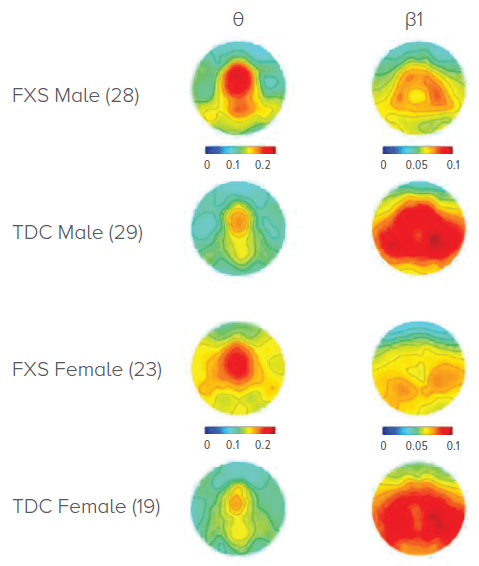Males with Fragile X Syndrome More Likely to Experience Auditory Processing Disruptions
Published June 2021 | Journal of Psychiatric Research
Clinicians have long hoped that electroencephalography (EEG) results could be effectively used as a biomarker for tracking neurological disruptions occurring in children born with fragile X syndrome (FXS). However, differing EEG patterns among males and females with the condition have complicated the effort.
Now, research led by first author Elizabeth G. Smith, PhD, and senior author Craig Erickson, MD, at Cincinnati Children’s, provides new insights that could make EEG results more useful to clinicians caring for children with FXS.
The team conducted an age- and sex-matched cluster-based analysis of children with and without FXS. The results did indicate several ways that EEG readings varied by biological sex. However, alterations in theta and low beta power measures were similar across males and females in FXS, and notably different from the control group.
“These EEG power patterns can complement research in preclinical models of FXS and may serve as a useful marker of neurobiological change in clinical trials,” the co-authors say.
Meanwhile, the team shows the first clear evidence of significant correlation between auditory processing and theta power in FXS males. In the auditory attention task from the Woodcock Johnson test of neurological function, altered theta power in males with FXS was strongly associated with an inability to filter speech out of background noise.
“This finding supports conceptualization of FXS as a signal processing disorder, whereby difficulty separating signal from noise across sensory systems leads to impairments in both perceptual and cognitive development,” the co-authors say.
Looking ahead, the study results support continued investigation of therapeutics targeting GABAergic and glutamateric dysregulation in FXS. However, it appears likely that therapeutics targeting the E/I balance as captured by excessive gamma band activity would have different effects in males and females.
Potential EEG Biomarker for Fragile X Syndrome
These topographic heat plots measuring relative EEG power indicate that males and females with fragile X syndrome (FXS) show a similar differentiation pattern compared to a control group (TDC) in the theta and low beta bandwidths. Warmer colors indicate greater relative power and cooler colors represent relative power approaching zero.






